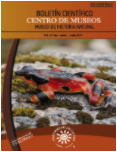Authors
Abstract
High levels of R. palmarum in chontaduro plantations mean the major limitation on crop yield. Based on the above, this research aims to evaluate the trapping of R. palmarum as an alternative to the indiscriminate use of chemical synthesis insecticides as conventional control for this pest. The trap design consisted of a 20 l gallon with lateral windows for the access of insects and inside there was fermented pineapple peel and sugar cane independently fermented in water and molasses for three days. Both semi-chemicals work separately in 30 ml vials with two 1 mm holes; Rhynchophorol C pheromone was used to increase the number of catches. A total of 3,106 adults of R. palmarum were collected. The collections are mainly associated with the stimulation of the endocrine system of the above mentioned insect by the semi-chemicals. Thus, at the time of arrival and stay in the trap and by chemical ecology, insects release aggregation pheromones and catches are enhanced. These results, in turn, have a perspective in the management of this important first order pest from a trapping that is harmless to the environment, is economic and therefore in line with the current needs of the farmers. Finally, this trap design does not require chemical synthesis insecticides for its operation which therefore, lowers the costs and risks to the ecosystem.
References
CARREÑO-CORREA, R.D., SALAZAR-MERCADO, S.A. & ESPINEL-RODRÍGUEZ, M., 2013.- Evaluación de cebos para el control de Rhynchophorus palmarum L. (Coleoptera: Curculionidae) en el cultivo de elaeis guineensis Jacq (Arecales: Arecaceae). Agron, 21 (2): 65-72.
FERREIRA, J.M., MDLDS, L., SARRO, F.B., ARAUJO, R.P. & MOURA, J.I.L., 2003.- Avaliação de diferentes fontes atrativas e suas prováveis interações na captura de Rhynchophorus palmarum. Manejo Integrado de Plagas y Agroecología, 67: 23-29.
GODOY, S.P., PENCUE, L., RUIZ, A. & MONTILLA, D.C., 2007.- Clasificación automática del chontaduro (Bactris gasipaes) para su aplicación en conserva, mermelada y harinas. Facultad de Ciencias Agropecuarias, 5 (2): 137-146.
HURTADO CAMACHO, R.E. & RINCÓN ROMERO, V., 2009.- La geomática como instrumento para modelar y hacer seguimiento a la pudrición del cogollo (PC) y al insecto plaga: Rhynchophorus palmarum. Zona Occidental - Tumaco (Colombia). Revista Palmas, 30 (3): 21-35.
ICA., 2011.- Manejo del picudo Rhynchophorus palmarum l. (Coleoptera: Curculionidae). ICA.
KARAM, M.Á., RAMÍREZ, G., MONTES, L.P.B. & GALVÁN, J.M., 2015.- Plaguicidas y salud de la población. CIeNCIA Ergosum, 11 (3): 246-254.
LANDERO-TORRES, I., GALINDO-TOVAR, M.E., LEYVA-OVALLE, O.R., MURGUÍA-GONZÁLEZ, J., PRESA-PARRA, E. & GARCÍA-MARTÍNEZ, M.Á., 2015.- Evaluación de cebos para el control de Rhynchophorus palmarum L. (Coleoptera: Curculionidae) en cultivos de palmas ornamentales. Entomología Mexicana, 2, 112-128.
LIN, Z., ZHEN, Z., WU, Z., JIEWEN, Y., ZHONG, L., HU, H., ZHANG, D., 2016.- The impact on the soil microbial community and enzyme activity of two earthworm species during the bioremediation of pentachlorophenol-contaminated soils. Journal of Hazardous Materials, 30, 35-45.
MAGALHÃES, J.A.S., DE MORAES NETO, A.H.A. & MIGUENS, F.C., 2008.- Nematodes of Rhynchophorus palmarum, L. (Coleoptera: Curculionidae), vector of the Red Ring disease in coconut plantations from the north of the Rio de Janeiro State. Parasitology Research, 102 (6): 1281-1287.
MAZZA, G., FRANCARDI, V., SIMONI, S., BENVENUTI, C., CERVO, R., FALEIRO, J. R. & ROVERSI, P.F., 2014.- An overview on the natural enemies of Rhynchophorus palm weevils, with focus on R. ferrugineus. Biological Control, 77: 83-92.
MIGUENS, F.C., MAGALHÃES, J.A.S., AMORIM, L.M., GOEBEL, V.R., LE COUSTOUR, N., LUMMERZHEIM, M., MOURA, J.I.L. & COSTA, R.M., 2011.- Mass Trapping and Biological Control of Rhynchophorus palmarum L.: A hypothesis based on morphological evidences. Entomo Brasilis, 4 (2): 49-55.
MURCIA, A.M. & STASHENKO, E., 2008.- Determinación de plaguicidas organofosforados en vegetales producidos en Colombia. Agro Sur, 36 (2): 71-81.
NIÑO, J., BUSTAMANTE, A.M., CORREA, Y.M. & MOSQUERA, M., 2007.- Evaluación de extractos vegetales para el control de la broca del café (Hypothenemus hampei, Ferrari). Scientia et Technica, 1 (33): 383-385.
PÉREZ, D., IANNACONE, J. & PINEDO, H., 2010.- Toxicological effect from the stem cortex of the amazonic plant soapberry Paullinia clavigera (Sapindaceae) upon three arthropods. Ciencia e Investigación Agraria: Revista latinoamericana de Ciencias de la Agricultura, 37 (3): 133-143.
PÉREZ, D. & IANNACONE, J., 2006.- Efectividad de extractos botánicos de diez plantas sobre la mortalidad y repelencia de larvas de Rhynchophorus palmarum L., insecto plaga del Pijuayo Bactris gasipaes Kunth en la Amazonía del Perú. Agricultura Técnica, 66 (1): 21-30.
RESTREPO, J., VINASCO, L.E. & ESTUPIÑAN, J.A., 2012.- Estudio comparativo del contenido de ácidos grasos en 4 variedades de chontaduro (Bactris gasipaes) de la región del Pacífico colombiano. Revista de Ciencias, 16: 123-129.
SÁENZ, A., 2005.- Aspectos generales e importancia del agente causal de anillo rojo. Revista Palmas, 26 (2): 59-70.
SEPÚLVEDA-CANO, P.A. & RUBIO-GÓMEZ, J.D., 2009.- Especies de Dryophthorinae (Coleoptera: Curculionidae) asociadas a plátano y banano (Musa spp.) en Colombia. Acta Biol. Colomb., 14 (2): 49-72.
SUMANO LÓPEZ, D., SÁNCHEZ SOTO, S., ROMERO NÁPOLES, J. & SOL SÁNCHEZ, Á., 2012.- Eficacia de captura de Rhynchophorus palmarum L. (Coleoptera: Dryophthoridae) con diferentes diseños de trampas en Tabasco, México. Fitosanidad, 16 (1): 43-48.

 PDF (Español)
PDF (Español)
 FLIP
FLIP






















